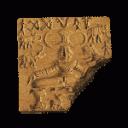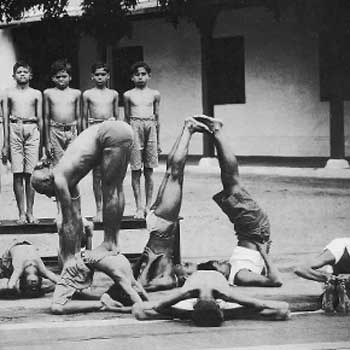veda & shastra – klassische Sanskritliteratur
Es gibt vier brahmanische Schriften: VEDA, SMRITI, PURANA, AGAMA. Wobei manche die agamas da sie als Spätwerk gelten zu der vedischen Literatur zählen,- oder nicht.
Weiters unterscheidet man zwischen sechs spirituellen und vier weltlichen Titeln, die da sind: 1) Shruti, 2) Smriti, 3) Itihasa, 4) Purana, 5) Agama und 6) Darshana; und 1) Subhashita, 2) Kavya, 3) Nataka und 4) Alankara.
Die Agamas sind theologische Abhandlungen und praktische Handbücher der Verehrung. Die Agamas beinhalten Tantras, Mantras und Yantras.
Nach dieser Unterteilung gibt es für jedes der vier Zeitalter Schriften, welche als autoritative Quellen für die jeweiligen Rituale und Übungen gelten. So gelten die Regelnd der shruti (veda), dabei nur für das „goldene Zeitalter“ (krta), in dem Wahrheit, Recht und Gerechtigkeit vorherrschen. Für das gegenwärtige „dunkle Zeitalter“ (kali) gelten hingegen die Regeln der Agamas (tantras). Diese sind Abhandlungen, die die äußere Gottesverehrung in Bildern, Tempeln usw. besprechen. Alle Agamas behandeln 1) Jnana, Wissen, 2) Yoga, Konzentration, 3) Kriya, Handeln und 4) Charya, Tun. Sie geben auch genaue Details über Ontologie, Kosmologie, Befreiung, Hingabe, Meditation, Mantraphilosophie, mystische Diagramme, Amulette und Zauberworte, Tempelbau, Herstellung von Bildern, häusliche Pflichten, soziale Regeln und öffentliche Feste.
Die Agamas teilen sich in drei Teile: Vaishnava, Shaiva und Shakta. Die drei Hauptströmungen im Hinduismus, nämlich Vaishnavismus, Shaivismus und Shaktismus, begründen ihre Lehren und Dogmas auf den jeweiligen Agamas. Die Vaishnava Agamas oder Pancharatra Agamas verherrlichen Gott als Vishnu. Die Shaiva Agamas verherrlichen Gott als Shiva und ließen eine wichtige philosophische Schule entstehen, den Shaiva Siddhanta. Die Shakta Agamas oder Tantras verherrlichen Gott als die Mutter der Welt unter einem der vielen Namen Devis. Die Agamas beziehen ihre Autorität nicht aus den Veden, sie widersprechen ihnen aber auch nicht. Sie sind alle in ihrem Geist und Charakter vedisch. Deshalb werden sie alle als maßgeblich betrachtet.
Die Tantra Agamas gehören zu Shakta, Puranas zu Shivas und Vishnu zu Vaishnava. Shakta verehren das Prinzip Shakti als die Mutter der Welt (devi). Sie beschränken sich auf den Shakti (Energie)-Aspekt Gottes und schreiben verschiedene Arten ritueller Verehrungen der Göttlichen Mutter vor. Es gibt 77 Agamas (Anm. hier varieren die Aufassungen °). Sie sind in mancher Hinsicht den Puranas sehr ähnlich. Die Texte sind meist Dialoge zwischen Shiva und Parvati.
In manchen von ihnen beantwortet Shiva die Fragen von Parvati (purana) und anderen, und Parvati beantwortet die Fragen Shivas (agama).
Mahanirvana, Kularnava, Kulasara, Prapanchasara, Tantraraja, Rudra Yamala, Brahma Yamala, Vishnu Yamala und Todala Tantra sind die wichtigen Werke. Die Agamas lehren okkulte Praktiken, wovon manche Kräfte geben, andere Erkenntnis und Freiheit. Unter den existierenden Büchern ist das Mahanirvana Tantra das berühmteste.
Siegel Industal mit asanas, 3000 v. Chr.
° The Shaktas have again been divided into three groups. Thus the esteemed Pandit R. Ananta Shastri in the Introduction to his edition of Anandalahari speaks of the Kaula or Shakta Shastras with sixty-four Tantras; the Mishra with eight Tantras; and the Samaya group which are said to be the most important of the Shakta Agamas, of which five are mentioned. This classification purports to be based on the nature of the object pursued, according as it belongs to one or the other of the Purusharthas. Pancaratra literature is very considerable, one hundred and eight works being mentioned by the same Pandit in Vol. XIII, pp. 357-363 of The Theosophist. I would refer the reader also to the very valuable edition of the Ahirbudhnya Samhita by my friend Dr. Otto Schrader, with an Introduction by the learned Doctor on the Pancaratra system where many Vaishnava Tantras and Samhitas are cited. The Trika school has many Tantras of which the leading one is Malinivijaya. The Svacchanda Tantra comes next. Jagadisha Chandra Chattopadhyaya Vidyavaridhi has written with learning and lucidity on this school. The Shaivasiddhanta has twenty-eight leading Tantras and a large number of Upagamas, such as Taraka Tantra, Vama Tantra and others, which will be found enumerated in Schomerus‘ Der Shaiva-siddhanta, Nallasvami Pillai’s Studies in Shaivasiddhanta (p. 294), and Shivajñanasiddihiyar (p. 211). The Sammohana Tantra (Ch. VI) mentions 64 Tantras, 327 Upatantras, as also Yamalas, Damaras, Samhitas and other Scriptures of the Shaiva class; 75 Tantras, 205 Upatantras, also Yamalas, Damaras, Samhitas of the Vaishnava class; numerous Tantras and other scriptures of the Ganapatya and Saura classes, and a number of Puranas, Upapuranas and other variously named Scriptures of the Bauddha class. It then (Ch. VII) mentions over 500 Tantras and nearly the same number of Upatantras, of some 22 Agamas, Cinagama (see Ch. VI post), Buddhagama, Jaina, Pashupata, Kapalika, Pancaratra, Bhairava and others. There is thus a vast mass of Tantras in the Agamas belonging to differing schools of doctrine and practice, all of which must be studied before we can speak with certainty as to what the mighty Agama as a whole is. In this book I briefly deal with one section of it only. Nevertheless when these Agamas have been examined and are better known, it will, I think, be found that they are largely variant aspects of the same general ideas and practices.
Comments are closed.



